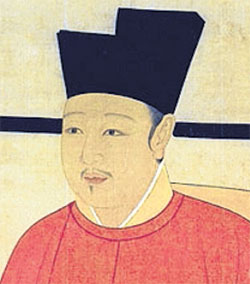How gardening led to the downfall of one Chinese emperor


Roula Khalaf, Editor of the FT, selects her favourite stories in this weekly newsletter.
From Nero’s Rome to Yanukovich’s Kiev, rulers’ ridiculous houses have been linked to their political collapse. At least the wall-paintings in Nero’s Golden House made an artistic impact. When they re-emerged hundreds of years later, they inspired the likes of Raphael to imitate them in their frescoes. Nobody, I trust, is thinking of doing a Kiev and cluttering their garden with a bad replica of a Spanish galleon. Palaces can be fatal but has anybody ever lost power because of a garden?
It looks unlikely that gardening will be François Hollande’s downfall. We can all agree that it was not the undoing of Lady Thatcher. The most plausible candidate for fatal gardening is Chinese, the Emperor Huizong, last of the Song dynasty. Contemporaries blamed his garden for their state’s ruin. It was not just a garden. It was an amazing rock garden, the biggest man-made mountain landscape until the Alpinum was built in Munich’s botanical garden in the years leading up to the first world war.
Huizong ruled from 1100 to 1125. This year, he has sprung back into western prominence. It is not only that he ordered a huge reform of schooling throughout his empire on lines that would delight UK education secretary Michael Gove. He even managed to impose it. He also founded, in 1114, a school of painting that would bring a gleam to the Prince of Wales’ eye. Thirty selected students were to study the traditional masters. Then, they would be judged for realism, originality and poetic imagination. Of course, they had to learn to draw. Huizong himself, emperor of the realm, wrote classicising poetry, painted most beautifully and cultivated a fine “golden-line” style of script. London’s Victoria and Albert Museum included two of the finest painted scrolls attributed to Huizong in its recent show of Chinese painting. I hope the hordes of visitors realised the astonishing rarity of what they were being shown. If not, they should read the impressive new biography of Emperor Huizong by Patricia Buckley Ebrey, a respected scholar of Song China. If you feel you know about Henry VIII but know nothing of the history of early China, this book is essential. It is based on Ebrey’s years of work on Chinese sources and is driven by an amiable wish to rehabilitate Huizong himself. Most of it is highly readable for outsiders.
One difference between Huizong and Yanukovich was that the Chinese emperor was artistic and profoundly educated in traditional classics. Another was his battery of concubines. Ebrey credits him with 13 “consorts”, up to 49 children and a supporting cast of 107 sex-girls. They tended to be retired when they reached the age of 32. He bestowed annual titles on the best ones, a practice now imitated by the University of Oxford for its tutors, which it calls a Recognition of Distinction exercise. The lowest grade was Talented One. Even so, according to Ebrey, “on the whole, Huizong’s consorts got along well”. Huizong even wrote a song for one of them, which, we are told, “the whole world sang”. That idea has yet to feature in Paris’s hit parade. He also wrote poems to favourites. Here is one of the best: “Peaches form her fragrant skin . . . Rare and gorgeous sewing, she can do it all. But all she cares to exert herself at is reading.” Unfortunately, her email address is not available.
In Huizong’s controversial garden, the consorts and concubines would take the air. At Kaifeng, just south of the Yellow river, the emperor lived inside a palace complex that was not, by Chinese standards, outrageously large. What became notorious was his man-made rock garden, which was up to 220ft high. To build it, Huizong sent orders for every sort of plant from all over his empire: lychees, gardenias, palms and plum trees. He also ordered the rarest and biggest stones. Chinese rulers had often been lithomaniacs but Huizong’s orders for waterworn rock outdid them all.

At the foot of this immovable mount, known as the Genyue, Huizong arranged big stones, some with markings like human faces. He had them honoured with plaques and poems, using gold letters if they were particularly distinguished. They were said to represent his ministers, an idea that has yet to be imitated in coalition Britain. Further up, the rockery divided into twin peaks. From here the emperor could look down on the outer suburbs of Kaifeng. Also, as Ebrey emphasises, he could hope to be visited by the Immortals and perhaps receive the gift of longevity.
Longevity was a traditional Chinese holy grail, not only the desire of a man among so many ladies. Stories circulated that the entire garden mountain had been built because the emperor wanted a son. His expert Daoist priest was supposed to have told him he would never father one if the ground was too flat. I love the idea. If you want to live long as a pensioner, build a huge rockery. Build one, above all, if you are running to daughters.
Importantly, Ebrey is dismissive of this famous story, which in her view was mere gossip. She observes that Huizong already had a son when he was only 17 and “from that point on, new sons were born at a steady rate”. She is much more insistent on the Daoist element. The Immortals might, indeed, descend to the peaks of Huizong’s rockery. He was a serious Daoist, she argues, and the religious dimension of his garden should not be underestimated. As in so much of his thinking, he wanted close relations with the heavenly powers of nature and the universe.
I have learnt about a new omen and a great fall. In 1126, barbaric Jurchen tribesmen from the north took Kaifeng and soon removed Huizong and thousands of captives to Manchuria. A monk describes how he and many others had sought refuge on the great mountain garden and how a sudden snowfall had shown the surrounding landscape and planting at its prettiest. Yet, after their capture, the people cut down the trees and “hated the names, records and poems written by the great ministers”. They smashed the plaques beside the gathering of rocks and threw them into the ditches. Huizong died far away in a Manchurian forest.
His vast rock garden was blamed for the catastrophe. Certainly, the shipping of so many huge rocks and plants had cluttered up the canals and transport system. There had also been endless corruption and compulsion during the entire high-speed plan. However, the garden alone cannot explain the loss of the whole of northern China. Huizong was trying to run a war from a faraway base and he was beset by treachery.
Not all the news had been bad. During the garden’s building, there had been sightings of what Chinese diviners called “numinous mushrooms”. Clusters of magic mushrooms even appeared near the newly founded medical school and were manifest signs of the Immortals’ favouring presence. After news of them spread, more such mushrooms were reported throughout the realm and sent in for Huizong’s approval.
This autumn, my lawn was unusually beset with uninvited mushrooms and I wondered why. Since then, Wall Street has continued to go up. In Kiev, however, not a sign of a numinous mushrooms has been reported from the former dictator’s garden.
‘Emperor Huizong’, by Patricia Buckley Ebrey, Harvard, £30
Comments